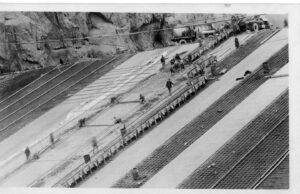News
The Cofferdam Construction on Hoover Dam

Construction of the upper coffer dam – pouring concrete onto the dam face.
By mid April in 1933 the two cofferdams that kept the waters of the Colorado River at bay during the construction work on Boulder Dam, now Hoover Dam, were complete.
Diversion tunnels had been excavated to take the course of the river through the rock face of the canyon, and around the dam site, but additional temporary dams were still needed to ensure the site remained dry. Throughout the winter of 1932/3, while the river was at its lowest, there was a race to have them finished before the Spring flood waters arrived from the snow thaw upstream.
Rock from the tunnels, plus river silt from the river bed, were used along with other fill from nearby Hemingway Wash, to create two cofferdams – one on either site of the construction site. Trucks raced back and forth with as many as 4000 truckloads of earth and rock being delivered every day.
When complete, the upper cofferdam stood 98ft high, 450ft across and 750ft thick at the base. The upstream face was protected by a 6″ thick concrete paving.
The race was won and the cofferdams held against the highest waters of the season and so construction on the dam began in earnest.